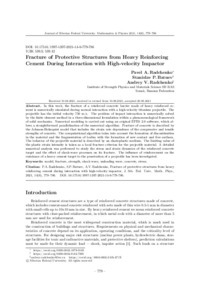Fracture of Protective Structures from Heavy Reinforcing Cement During Interaction with High-velocity Impactor
Скачать файл:
URI (для ссылок/цитирований):
https://elib.sfu-kras.ru/handle/2311/144770Автор:
Radchenko, Pavel A.
Batuev, Stanislav P.
Radchenko, Andrey V.
Радченко, Павел А.
Батуев, Станислав П.
Радченко, Андрей В.
Дата:
2021-11Журнал:
Журнал Сибирского федерального университета.Математика и физика.Journal of Siberian Federal University. Mathematics & Physics, 2021 14 (6)Аннотация:
In this work, the fracture of a reinforced concrete barrier made of heavy reinforced ce-
ment is numerically simulated during normal interaction with a high-velocity titanium projectile. The
projectile has the initial velocity 750 m/s. The problem of impact interaction is numerically solved
by the finite element method in a three-dimensional formulation within a phenomenological framework
of solid mechanics. Numerical modeling is carried out using an original EFES 2.0 software, which al-
lows a straightforward parallelization of the numerical algorithm. Fracture of concrete is described by
the Johnson-Holmquist model that includes the strain rate dependence of the compressive and tensile
strengths of concrete. The computational algorithm takes into account the formation of discontinuities
in the material and the fragmentation of bodies with the formation of new contact and free surfaces.
The behavior of the projectile material is described by an elastoplastic medium. The limiting value of
the plastic strain intensity is taken as a local fracture criterion for the projectile material. A detailed
numerical analysis was performed to study the stress and strain dynamics of the reinforced concrete
target and the effect of shock-wave processes on its fracture. The influence of reinforcement on the
resistance of a heavy cement target to the penetration of a projectile has been investigated В работе численно моделируется разрушение железобетонной преграды из тяжелого
армоцемента при нормальном взаимодействии с высокоскоростным титановым ударником. Начальная скорость ударника составляла 750 м/с. Задача ударного взаимодействия решается численно в
трехмерной постановке в рамках феноменологического подхода механики сплошной среды. Численное моделирование проводится с использованием авторского программного комплекса EFES 2.0,
позволяющего эффективно распараллелить вычислительный алгоритм. Разрушение бетона описывается моделью Джонсона – Холмквиста с учетом зависимости прочности бетона на сжатие и
растяжение от скорости деформации. Вычислительный алгоритм учитывает разрушение материала и фрагментацию тел с образованием новых контактных и свободных поверхностей. Поведение
материала ударника описывается упругопластической средой. В качестве критерия локального
разрушения материала ударника принимается предельное значение интенсивности пластической
деформации. Проведен подробный численный анализ динамики напряженно-деформируемого состояния железобетонной преграды и влияния ударно-волновых процессов на ее разрушение. Исследовано влияние армирования на сопротивление преграды из тяжелого армоцемента прониканию
ударника

